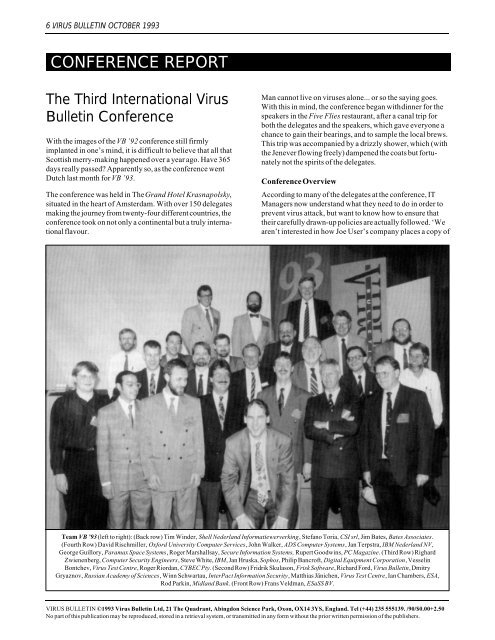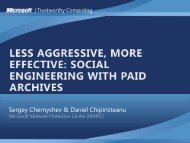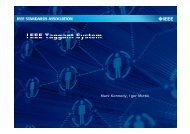VB'93 conference report - Virus Bulletin
VB'93 conference report - Virus Bulletin
VB'93 conference report - Virus Bulletin
You also want an ePaper? Increase the reach of your titles
YUMPU automatically turns print PDFs into web optimized ePapers that Google loves.
6 VIRUS … BULLETIN OCTOBER 1993<br />
CONFERENCE REPORT<br />
The Third International <strong>Virus</strong><br />
<strong>Bulletin</strong> Conference<br />
With the images of the VB ’92 <strong>conference</strong> still firmly<br />
implanted in one’s mind, it is difficult to believe that all that<br />
Scottish merry-making happened over a year ago. Have 365<br />
days really passed? Apparently so, as the <strong>conference</strong> went<br />
Dutch last month for VB ’93.<br />
The <strong>conference</strong> was held in The Grand Hotel Krasnapolsky,<br />
situated in the heart of Amsterdam. With over 150 delegates<br />
making the journey from twenty-four different countries, the<br />
<strong>conference</strong> took on not only a continental but a truly international<br />
flavour.<br />
Man cannot live on viruses alone... or so the saying goes.<br />
With this in mind, the <strong>conference</strong> began with dinner for the<br />
speakers in the Five Flies restaurant, after a canal trip for<br />
both the delegates and the speakers, which gave everyone a<br />
chance to gain their bearings, and to sample the local brews.<br />
This trip was accompanied by a drizzly shower, which (with<br />
the Jenever flowing freely) dampened the coats but fortunately<br />
not the spirits of the delegates.<br />
Conference Overview<br />
According to many of the delegates at the <strong>conference</strong>, IT<br />
Managers now understand what they need to do in order to<br />
prevent virus attack, but want to know how to ensure that<br />
their carefully drawn-up policies are actually followed. ‘We<br />
aren’t interested in how Joe User’s company places a copy of<br />
Team VB ’93 (left to right): (Back row) Tim Winder, Shell Nederland Informatiewerverking, Stefano Toria, CSI srl, Jim Bates, Bates Associates.<br />
(Fourth Row) David Rischmiller, Oxford University Computer Services, John Walker, ADS Computer Systems, Jan Terpstra, IBM Nederland NV,<br />
George Guillory, Paramax Space Systems, Roger Marshallsay, Secure Information Systems, Rupert Goodwins, PC Magazine. (Third Row) Righard<br />
Zwienenberg, Computer Security Engineers, Steve White, IBM, Jan Hruska, Sophos, Philip Bancroft, Digital Equipment Corporation, Vesselin<br />
Bontchev, <strong>Virus</strong> Test Centre, Roger Riordan, CYBEC Pty. (Second Row) Fridrik Skulason, Frisk Software, Richard Ford, <strong>Virus</strong> <strong>Bulletin</strong>, Dmitry<br />
Gryaznov, Russian Academy of Sciences, Winn Schwartau, InterPact Information Security, Matthias Jänichen, <strong>Virus</strong> Test Centre, Ian Chambers, ESA,<br />
Rod Parkin, Midland Bank. (Front Row) Frans Veldman, ESaSS BV.<br />
VIRUS BULLETIN ©1993 <strong>Virus</strong> <strong>Bulletin</strong> Ltd, 21 The Quadrant, Abingdon Science Park, Oxon, OX14 3YS, England. Tel (+44) 235 555139. /90/$0.00+2.50<br />
No part of this publication may be reproduced, stored in a retrieval system, or transmitted in any form without the prior written permission of the publishers.
F-Prot on every workstation’, commented one delegate.<br />
‘What we want is to understand how to enforce the rules,<br />
and what can go wrong.’<br />
The <strong>conference</strong> attempted to answer some of these problems,<br />
but more than anything served to differentiate the needs of<br />
the users from those of the anti-virus industry. Exactly as last<br />
year, users are increasingly frustrated by the anti-virus<br />
manufacturers’ schoolboy fascination with competing sizes<br />
of virus collections - what they need is a solution.<br />
Up to Speed<br />
The delegates had already been treated to the infamous Steve<br />
White-Jan Hruska <strong>Virus</strong>-101 course the evening before the<br />
<strong>conference</strong> began, but IBM wanted to reinforce this message.<br />
A good virus defence policy is built on several very simple<br />
precepts, and the opening talk by Jan Terpstra attempted to<br />
drum this maxim home.<br />
However, a far more thorny problem is that of what to do<br />
when something has gone wrong. A virus is loose on your<br />
computer system. It is not identified by current anti-virus<br />
software, and is highly destructive. What should you do<br />
now? This is exactly the situation David Rischmiller, from<br />
Oxford University Computer Services, found himself in.<br />
Summing up the situation in early 1991 at OUCS,<br />
Rischmiller was disarmingly frank. ‘At the start of 1991 we<br />
were aware of viruses; we had been subscribers to the<br />
<strong>Virus</strong>-l mailing list for some time; we were giving anti-virus<br />
advice to our users; and were taking simple anti-virus<br />
precautions with the machines under our control which were<br />
available for public use. We had even made a start on<br />
producing a document about computer viruses and their<br />
prevention ... for all that, we were naïve about the issues.’<br />
Rischmiller then went on to explain about the unforeseen<br />
problems which the virus (in this case, Spanish Telecom)<br />
caused within the university. One interesting side-effect of<br />
the problem was that the users became increasingly paranoid<br />
about the nature of the virus infection which was spreading<br />
throughout the university - a problem which PC support staff<br />
will know all too well.<br />
One problem which seems set to affect OUCS for the<br />
foreseeable future is that of ‘haunting’ by the Spanish<br />
Telecom virus, as machines become infected from one of the<br />
many infected floppy diskettes which are mouldering in a<br />
forgotten corner of an office. ‘If there has been a serious<br />
outbreak,’ explains Rischmiller, ‘everyone is eager to do the<br />
right thing, but as the memory fades, so does the enthusiasm.<br />
I don’t think there is any way of stopping this in a university<br />
environment. You can take a horse to water...’<br />
A Sense of Security<br />
Not everyone in the anti-virus industry has the same perspective<br />
on how to go about preventing the spread of computer<br />
viruses. The most controversial talk of the <strong>conference</strong> was on<br />
an alternative approach to virus prevention.<br />
VIRUS BULLETIN OCTOBER 1993 7…<br />
Winn Schwartau, the cause of the furore, believes that the<br />
current approach to virus prevention is simply wrong, and<br />
that by using well known security techniques it is possible to<br />
limit the spread of computer viruses within an organisation.<br />
‘As most security professionals probably already know, I am<br />
not a big fan of virus busting’, began Schwartau, before<br />
embarking on a no-holds-barred critique of the industry.<br />
Schwartau argued that a better way to prevent viruses is to<br />
use a combination of the security systems one might find on<br />
a large mainframe system. He believes this is a better system<br />
for a number of reasons:<br />
• It will cost less money than is currently spent on antivirus<br />
software<br />
• It will save the man-hours spent on keeping anti-virus<br />
software up to date<br />
• It will provide protection against unknown viruses as well<br />
as known ones<br />
• It will provide a number of additional benefits which are<br />
badly needed by the corporate IT manager.<br />
As he was led to the Guillotine, Monsieur Bontchev was heard to<br />
mutter ‘Let them use DEBUG...’<br />
The delegates and speakers seemed to be divided by<br />
Schwartau’s assertions. Vesselin Bontchev gave a lengthy<br />
multi-point argument against Schwartau (he did not agree<br />
with any of the points Schwartau raised!) and his views<br />
reflected those of several of the speakers and a proportion of<br />
the audience. However, the remainder of the delegates were<br />
very interested in what Schwartau’s model had to offer. The<br />
acid test of his ideas will be how they fare on large systems<br />
over a period of time - meanwhile the jury is still out on this<br />
one. Debate over Schwartau’s ideas continued through the<br />
rest of the <strong>conference</strong>.<br />
Reviewing the Reviewers<br />
On a more technical note, Vesselin Bontchev gave an<br />
informative account of how virus scanners should be tested.<br />
He explained that the biggest problem is maintaining a virus<br />
VIRUS BULLETIN ©1993 <strong>Virus</strong> <strong>Bulletin</strong> Ltd, 21 The Quadrant, Abingdon Science Park, Oxon, OX14 3YS, England. Tel (+44) 235 555139. /90/$0.00+2.50<br />
No part of this publication may be reproduced, stored in a retrieval system, or transmitted in any form without the prior written permission of the publishers.
8 VIRUS … BULLETIN OCTOBER 1993<br />
collection: if the virus test-set used to examine<br />
anti-virus software is at fault, the test results are<br />
not valid.<br />
However, the process of ‘weeding’ a large<br />
collection of the junk and joke programs which it<br />
contains is non-trivial. A typical ‘virus collection’<br />
may consist of megabytes of data, much of<br />
which will not be of interest to the virus researcher<br />
- however, it all must be examined, in<br />
case it contains new viruses. Bontchev went on<br />
to describe how this should be done:<br />
One of the most common mistakes to make<br />
when compiling a virus collection is the inclusion<br />
of first-generation virus droppers (which<br />
Bontchev further classifies as germs, droppers<br />
and injectors). The problem with such files is<br />
that although they replicate, they do not represent<br />
a typical infection, and therefore should not<br />
be included when testing scanners.<br />
Bontchev concluded that even after many<br />
months of effort, the <strong>Virus</strong> Test Centre in<br />
Hamburg was still not ready to review products<br />
as thoroughly as he would like.<br />
The approach adopted by PC Magazine was<br />
somewhat less scientific. The PC Magazine<br />
reviews weighted the usability of the software<br />
much more highly, explained Rupert Goodwins.<br />
Goodwins’ virus detection tests were undoubtedly<br />
less rigorous, but gave his readers an idea of<br />
the ‘feel’ of the product. Goodwins then faced a<br />
barrage of questions from the more technically<br />
oriented members of the audience.<br />
The ideal way to review anti-virus software has<br />
yet to be discovered, but such open discussions<br />
lead the way to better reviews for us all - the<br />
final recipe for the perfect review probably being<br />
a mixture of the VTC’s scientific zeal and PC<br />
Magazine’s ‘touch and feel’.<br />
New <strong>Virus</strong> Trends<br />
Noticeably absent from this year’s <strong>conference</strong><br />
were some of the heavyweight technical papers<br />
presented in Edinburgh: hopefully there will be a<br />
stronger technical flavour to next year’s event.<br />
However, the technical presentations were still<br />
one of the <strong>conference</strong> highlights.<br />
One depressingly accurate talk was supplied by<br />
Tim Twaits, of Sophos. This examined a range<br />
of virus construction toolkits which seem to have<br />
grown in number overnight. Twaits cautioned<br />
that although the toolkits did not present too<br />
large a threat at this time, more ‘products’ were<br />
doubtless in the pipeline.<br />
Schwartau recommends using a combination of security measures...<br />
...delegates test his theory after the Gala Dinner.<br />
One increasingly popular technique used for combating viruses is<br />
heuristic analysis - a method which has long been surrounded by an aura<br />
of black magic. Fortunately, Frans Veldman from ESaSS was intent on<br />
demystifying the entire heuristic procedure and explained to delegates<br />
how his company approached the issue... and unbelievers will be pleased<br />
to learn that there were no rams’ heads, black candles or Latin incantations<br />
involved!<br />
Blue Notes and Red Lights<br />
On a closing note, the <strong>conference</strong> was not all work. With the venue<br />
being so close to the very heart of Amsterdam, there was much sightseeing<br />
and merry-making after hours.<br />
The gala dinner proved to be less inflammable but at least as enjoyable<br />
as last year. Held in the Winter Garden restaurant at the hotel, the<br />
evening comprised a combination of fine food, music and entertainment,<br />
by the very capable magicians John and Saxon. The high point of the<br />
event was watching Vesselin Bontchev being placed on a working<br />
guillotine, although this was rivalled by the sight of CPAV product<br />
manager Tori Case seemingly floating in the air. The magician was not<br />
open to any bribes regarding either of his helpers’ personal safety, and<br />
both Tori and Vesselin survived the evening unscathed!<br />
After these excitements, the band led the party on until 1.00am - joined<br />
for the last few numbers by master saxman Jim Bates and the Editor of<br />
VB. ‘It would never have happened in my day!’ <strong>Virus</strong> <strong>Bulletin</strong>’s erstwhile<br />
Editor, Edward Wilding, muttered darkly.<br />
Once again, thanks are due to Petra Duffield, who consistently produces<br />
perfectly organised <strong>conference</strong>s, and all her helpers. Several people<br />
deserve the <strong>Virus</strong> <strong>Bulletin</strong> award for dedication well beyond the call of<br />
duty: namely Karen Richardson, Victoria Lammer, Rosalyn Rega at<br />
Expotel International Groups and all the staff at Crypsys.<br />
Thanks are also well earned by the speakers, but particularly by all the<br />
delegates, whose lively discussions make the <strong>Virus</strong> <strong>Bulletin</strong> <strong>conference</strong><br />
the event it is. Where will the <strong>conference</strong> be next year? Well - watch this<br />
space, as great plans are afoot...<br />
VIRUS BULLETIN ©1993 <strong>Virus</strong> <strong>Bulletin</strong> Ltd, 21 The Quadrant, Abingdon Science Park, Oxon, OX14 3YS, England. Tel (+44) 235 555139. /90/$0.00+2.50<br />
No part of this publication may be reproduced, stored in a retrieval system, or transmitted in any form without the prior written permission of the publishers.





